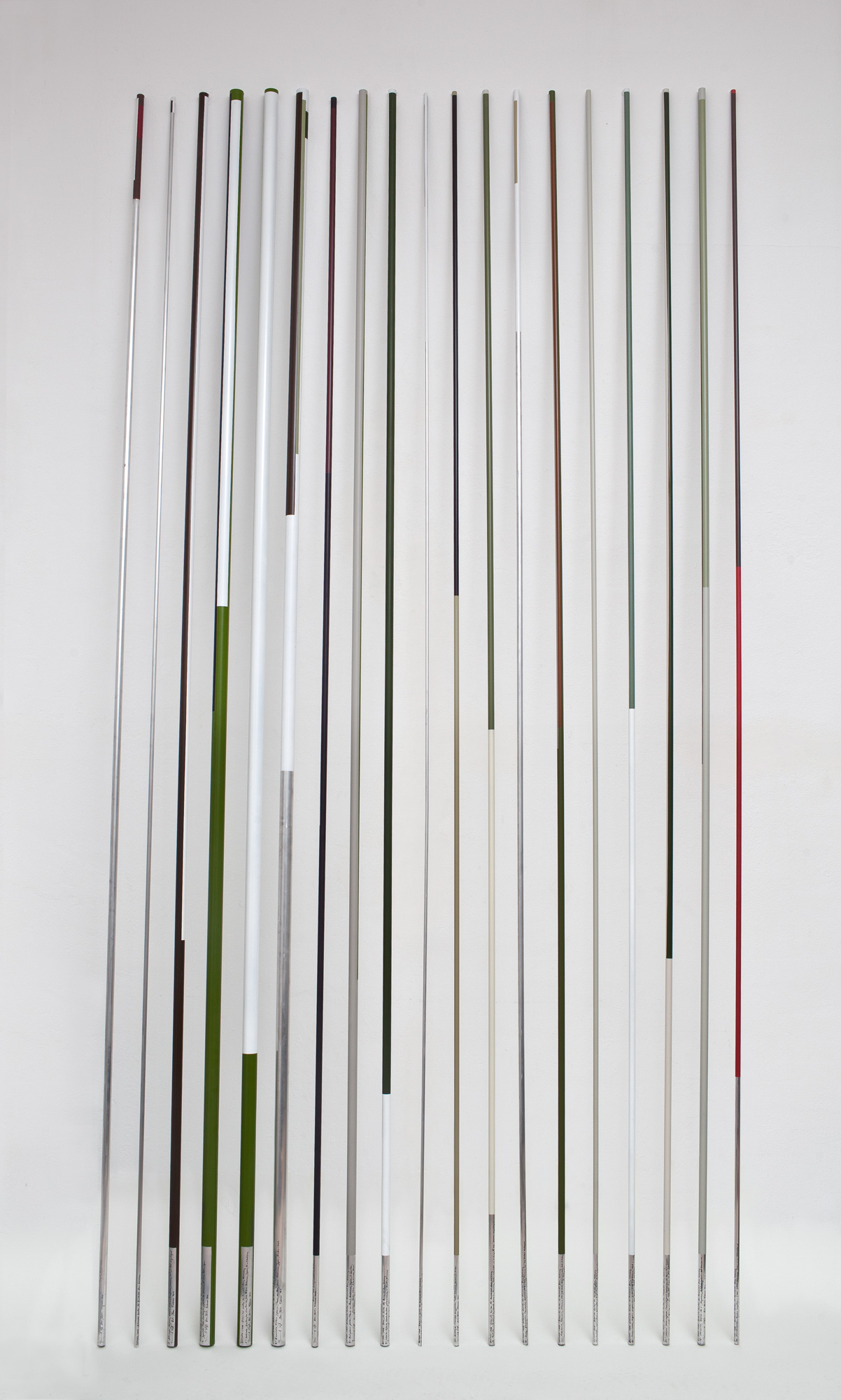
BOTANIC CODE – Botanischer Garten der Universität Bonn, Germany (February 2010)
Jorinde Voigt
Bonn, Berlin 2010
(19 Stangen) + 1 Buch Konzept (40 Seiten)
300 cm x diverse
Aluminium, Industrielack, Tinte, Unikate
Aluminium, industrial varnish, ink, unique
1 Strauchpfingstrose, Paeonia suffruticosa – Hybride, cv. Rimpoh, Paeoniaceae / Ø Stange: 18 mm x Länge der Stange: 300 cm WV 2010-624
2 Pfingstrose, Paeonia lactiflora Pall., Paeoniaceae, China, Sibirien /Ø Stange: 10 mm x Länge der Stange: 300 cm WV 2010-625
3 Blauregen, Glyzinie, Wisteria sinensis (Sims) Sweet, Fabaceae, China, in USA eingebürgert / Ø Stange: 24 mm x Länge der Stange: 300 cm WV 2010-626
4 Japanischer Pfeffer, Zanthoxylum piperitum DC. Rutaceae, N-China, Korea, Japan / Ø Stange: 35 mm x Länge der Stange: 300 cm WV 2010-627
5 Gelbholz, Zanthoxylum alianthoides, Sieb. & Zucc. Rutaceae, Japan, N- und Mittel-China / Ø Stange: 35 mm x Länge der Stange: 300 cm WV 2010-628
6 Zimmeralie, Fatsia japonica (Thunb. ex Murr.) Decne. Araliaceae, Japan, Riukiu-Inseln / Ø Stange: 32 mm x Länge der Stange: 300 cm WV 2010-629
7 Schneeglöckchenbaum, Halesia carolina L. Styracaceae, USA; Virginia-Ohio, Illinois, Südl. Georgia, Florida, O-Texas / Ø Stange: 15 mm x Länge der Stange: 300 cm WV 2010-630
8 Kalopanax pictus (Thunb. ex Murr.), Araliaceae, Japan, S-Kurilen, Sacchalin, Korea, China Mandschurei, Ussuri / Ø Stange: 22 mm x Länge der Stange: 300 cm WV 2010-631
9 Inkarho-Hybride, Rhododendron yakushimanum,cv. Blurettia, Ericaceae / Ø Stange: 20 mm x Länge der Stange: 300 cm WV 2010-632
10 Rhododendron, Kiusianum-Hybride, cv. Rauschenstein, Ericaceae/ Ø Stange: 8 mm x Länge der Stange: 300 cm WV 2010-633
11 Goldregen, Laburnum anagyroides, Medik. Fabaceae, Zentral-, S-Europa / Ø Stange: 12 mm x Länge der Stange: 300 cm WV 2010-634
12 Pfahlrohr (o. Riesenschilf) Arundo donax L., Poaceae, Medit. Transkauk., in S-Europa & trop. Amerika eingebürgert / Ø Stange: 15 mm x Länge der Stange: 300 cm WV 2010-635
13 Zwerg-Bambusrohr, Pleiobastus distichus (Mitf.) Nak., Poaceae, nur aus Kultur bekannt / Ø Stange: 14 mm x Länge der Stange: 300 cm WV 2010-636
14 Araukarie, Araucaria, araucana (Mol.) K. Koch, Araucariaceae, Geb. S-Chiles, N-Patagonien / Ø Stange: 16 mm x Länge der Stange: 300 cm WV 2010-637
15 Kopfeibe, Cephalotaxus harringtonii (Knight ex J. Forbes) K. Koch, Cephalotaxaceae, N-, S-Korea, Japan / Ø Stange: 12 mm x Länge der Stange: 300 cm WV 2010-638
16 Mammutbaum, Sequoia sempervirens (D.Don) Endl., Taxodiaceae, USA, SW-Oregon – Mittel-Kalifornien / Ø Stange: 15 mm x Länge der Stange: 300 cm WV 2010-639
17 Lawsons Scheinzypresse, Chamaecyparis lawsoniana,Curpressaceae, SW-Oregon bis NW-Kalifornien / Ø Stange: 16 mm x Länge der Stange: 300 cm WV 2010-640
18 Steineiche, Quercus ilex L., Fagaceae, Mittelmeergebiet – NW-Frankreich / Ø Stange: 18 mm x Länge der Stange: 300 cm WV 2010-641
19 Stachelnüsschen, Acaena magellanica, Patagonien, Feuerland / Ø Stange: 12 mm x Länge der Stange: 300 cm WV 2010-642
WV 2010-624 bis 642